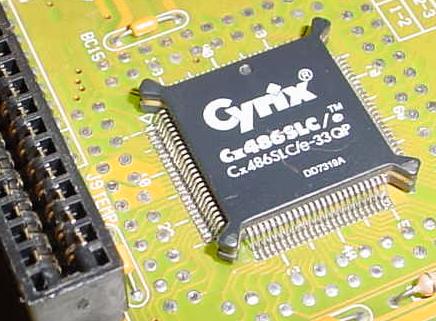
Cyrix began in 1988 as a specialist manufacturer of high-performance maths co-processors for 286 and 386 systems. The company was founded by ex-Texas Instruments staff, and had a long but rather troubled relationship with TI from that time on.
Cyrix founder Jerry Rogers was a hard-driving, abrasive leader who head-hunted the best engineers in the USA and pushed them mercilessly. His tiny 30-man design team set themselves the absurdly ambitious task of first matching, and then beating performance leader Intel at its own game — and succeeded.
Much of the credit for this belongs to Jerry Rogers himself. As an aggressive, go-getting leader he took Cyrix from nothing to the mighty 6x86, a faster chip than Intel's best.
But it's no use having the best chip in the world if no-one is buying it, and this was where Rogers was weak: Cyrix had great product and fantastic pricing but needed a major OEM customer — an IBM, a Compaq, or a Dell to give them long-term, steady contracts. Sure, they had always done well in the independent market with the smaller specialist shops, but a well-balanced order book has a mix of customers, large and small.
As AMD had also found out the hard way, in those days the bigger PC manufacturers had to be very, very careful in their dealings with Intel — or more to the point, in their dealings with Intel competitors. A system manufacturer which started buying CPUs from AMD or Cyrix, before too long, could reasonably expect to see competitors getting shipments of the latest Intel CPU or chipset while they themselves were missing out. Intel have always flatly denied that there ever was a black list, but it has been called "the worst-kept secret in the industry".
On the other hand, people often make too much of this sort of thing. We certainly don't have a black list, but if it's only possible to do one of two jobs — perhaps the components are in short supply, or we can't squeeze them both into the workshop schedule this week — our regular customers always come first. We believe that looking after your regulars first is just good business. Why should Intel be any different?
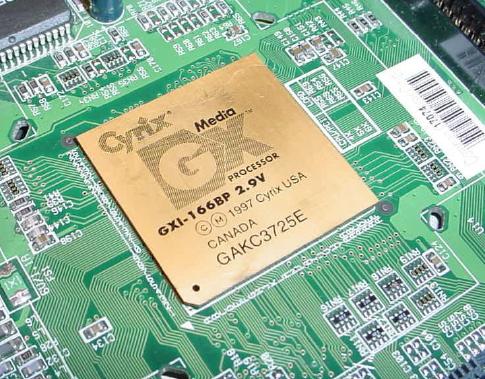
Even so, it was not impossible to sell CPUs to the major PC makers — AMD had done it after all — but Cyrix could never quite close the big deals. Eventually Cyrix dispensed with founder Jerry Rogers as CEO and added marketing people to the board instead. Within just a few months Cyrix had sold the MediaGX to Compaq and other big sales soon followed. In the short to medium term, this was good news for Cyrix. In the longer term, we wondered if the new management structure could get the same incredible design productivity as Cyrix had been blessed with in Jerry Rogers' day, and these fears were to prove more than justified.
Cyrix had always been a fabless manufacturer: in other words, the company designed and sold its own parts, but farmed the actual manufacture out to outside contractors. In the early days Cyrix mostly used Texas Instruments or SGS Thompson production facilities. In 1994, following a series of disagreements with TI, and in search of high-tech, thin-wafer production to match the facilities of AMD and Intel, Cyrix turned to IBM Microelectronics. For the next four years, Cyrix CPUs were all made by IBM. As part of the deal, IBM got to make its own Cyrix-designed CPUs royalty-free.
Unlike AMD, Cyrix had never manufactured or sold Intel designs under license, but designed everything in-house, from the ground up.While the AMD's 386s and even 486s had some Intel-written microcode software, the Cyrix chips were all completely independent, clean-room designs.
Intel has never tolerated competition well, and spent many years in the courts claiming that the Cyrix 486 violated Intel patents. (Intel dd this with every X86 CPU manufacturer right up until 1998 — yes, every single one.) By and large, Intel lost the Cyrix case. But the settlement was out of court: Intel agreed that Cyrix had the right to produce its own X86 designs in any foundry that happened to already hold an Intel license. Both firms gained from it: Cyrix could carry on having CPUs made by Texas Instruments, SGS Thompson, or IBM (as it happened, all holders of Intel cross-licenses); Intel avoided complete open slather in the X86 market. Both firms were (presumably) happy to avoid yet another round of mindless and expensive litigation.

The follow-on 1997 Cyrix-Intel litigation was the reverse: Cyrix claimed that Intel's Pentium Pro and Pentium II violated Cyrix patents — in particular, power management and register renaming techniques. The case was expected to drag on for years but ended up being settled promptly with another mutual cross license agreement. This gave both firms full and free access to each others patents — a remarkably sensible resolution that let both firms get on with real work like making better CPUs. Notice that it neatly avoided the issue of law: such a settlement didn't say whether the Pentium Pro violated Cyrix patents or not, it simply allowed Intel to carry on making them either way — exactly as the previous settlement side-stepped Intel's claim that the Cyrix 486 violated Intel patents.
Meanwhile, in August 1997 (as the litigation was still in progress) Cyrix merged with National Semiconductor, a firm that already held an Intel cross-license. This provided Cyrix with an extra marketing arm and access to National Semiconductor fab plants — so far as manufacturing technology goes, RAM and CPUs are very similar, so the NatSemi , which were originally constructed to produce RAM and high-speed telecommunications equipment. The IBM manufacturing agreement remained for a while longer, but Cyrix eventually switched all their production over to National's plant. The merger improved Cyrix's financial base, and give them much better access to development facilities. (When you don't own your own fab plant, it's much harder to get rush jobs pushed through for testing purposes. This was one of Cyrix's biggest complaints about IBM.)
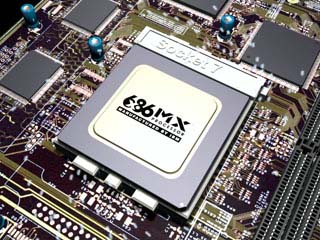
The merger also resulted in a change of emphasis: National Semiconductor's priority was single-chip budget devices like the MediaGX, rather than the higher performance chips that Cyrix had traditionally made. NatSemi clearly lacked confidence in Cyrix's ability to compete at the high end of the performance spectrum. We found this difficult to understand. Cyrix had long since demonstrated an ability to design outstanding CPUs — the 6x86 200 Classic was the fastest X86 chip in the world for quite some time, and the first CPU in 18 years to break Intel's stranglehold on the ultimate performance crown — and this despite the twin disadvantages of very limited development capital and less than ideal manufacturing arrangements.
Now that Cyrix had National Semiconductor's fab plants and reserves of capital behind it, the firm should have been more able to compete with high-end AMD and Intel products, not less. Perhaps NatSemi believed that the high-end looked promising, but the low-end was an absolute certainty, given that the MediaGX family parts had no real competition. Even so, Cyrix made it clear that the company would continue development of high-performance chips too, not least because of the need for ever higher performance cores for the multi-purpose single-chip devices. As we feared, however, under National Semiconductor's management Cyrix lost focus on the high-performance products in favour of the MediaGX line.
By mid-1999, it was clear to all observers that NatSemi had lost the plot: it took Cyrix almost a year to push the MII from PR-300 to PR-333, and despite occasional promises, the flow of good new products was no more than exactly that — promises. In May, Cyrix finally admitted that it no longer had the ability to compete with the majors. As things stood, it was obvious that Cyrix would soon disappear forever. At the time we wrote:
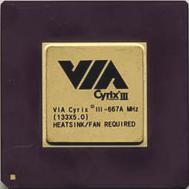
"Is it not extraordinary that a company which pulled itself up by its bootstraps, which rose from nothing to become a genuine contender — and did it on a shoestring budget amid constant legal harassment — could find itself, almost overnight, in the much more comfortable position of at last having a large and wealthy parent company, with complete freedom from legal worries — and then fail miserably? Truly, NatSemi seem to have the Novel touch."
"For the good of the industry, we hope that someone will buy what's left of Cyrix before it's too late. Even now, Cyrix retains about six percent of the global CPU market — which is a far more than anyone except Intel and AMD — and, if they have not all left by now, one of the world's best design teams. Rumoured buyers include IBM, Samsung, and AMD. IBM has the capital, the production facilities, the distribution channels, and a demonstrated ability to shoot itself in the foot second only to NatSemi's. AMD needs all its capital for the K6-III and K7 products. Of these three, Samsung look to be far and away the best suited. Consider for a moment Hyundai's enormously successful venture with bankrupt hard drive manufacturer Maxtor — we see no reason why a Samsung could not bring some Asian drive and management expertise in to revitalise the once-great name of Cyrix."
Alas, it was not to be. Cyrix was left to stagger along for several months longer: bereft of management direction, with morale at an all-time low, and loosing its best engineers one by one. In the end, VIA bought the feebly-twitching remains for a handful of small change. By this time that wonderful development team was no more, the Cyrix products were hopelessly out of date, and the only thing left of value was the Cyrix name.
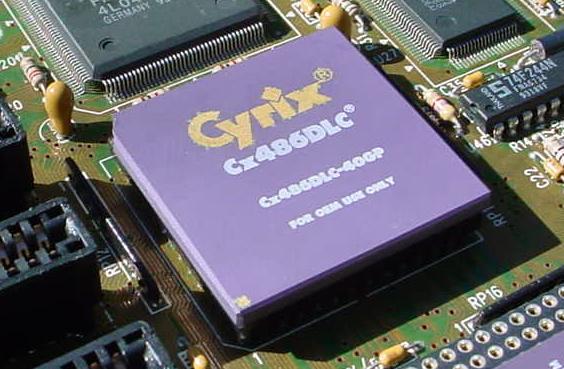
Over its short history, Cyrix had a huge influence on the average PC buyer, even the buyer who has never owned a Cyrix chip.
Cyrix and AMD between them lowered the cost of computing by many hundreds of dollars — and lowered it for both their own customers and for Intel buyers too. Every time you bought a PC with an Intel chip, you saved several hundred dollars simply because Cyrix (and AMD) had forced Intel to charge a more reasonable price. Every time you bought a PC with a Cyrix chip, you saved even more. Here at Red Hill, where we have never been prepared to sacrifice quality and yet are always looking for ways to give better value, Cyrix CPUs were a major part of our success for many years. The money we saved on the CPU went straight back into other parts of the system: more RAM, a better monitor, a quality sound card, or a really fast hard drive. The 486DLC, the Cyrix DX/2-66, the 5x86 and the 6x86, over the years, gave us excellent service and saved our customers many, many thousands of dollars. (We should also give credit here to the wonderful old AMD 386DX-40, the AMD486DX/4-100, and the IBM 486SLC/2-66.)
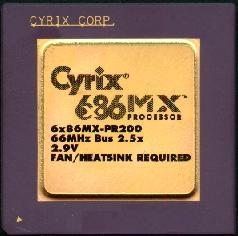
So long as Cyrix CPUs kept on offering the best performance at the lowest cost, they remained our most popular choice here at Red Hill. At one stage, before AMD got the K6 out and Intel cut Pentium prices by almost 50%, we sold three times as many 6x86 Classics as every other CPU combined.
Later in 1997 the difference became much smaller, and we used the 6x86, the Pentium-MMX, and the K6 in almost equal numbers. When the 6x86MX become available in quantity (January 1998), it in turn became our best seller. But as the Cyrix management malaise started to make itself felt, the main chip for the second half of 1998 was the AMD K6-2, not the M-2/300. Cyrix parts gradually fell further and further away from the performance mark, and their natural application shrank: to the mid-range, to the entry-level, and eventually to nothing at all. VIA's Cyrix-badged, Centaur-designed parts were too little too late, and we bought just one of them, a sample, which did not particularly impress us.
As a salable product line, Cyrix are gone beyond all hope of recovery now, but the firm has left a legacy of affordable performance which continues to shape the PC industry and benefit consumers to this day.